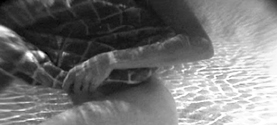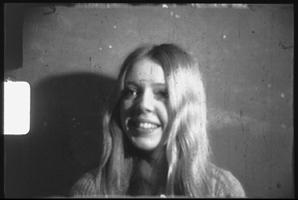These Days, the title of a recent group exhibition at the Vancouver Art Gallery curated by Grant Arnold, immediately conjures up a preoccupation with the present, of our present moment as era. This is made manifest by the first piece encountered at the top of the escalator: the white glow of the show’s title in neon by Ron Terada. This Nauman or Kosuth-like work approaches the tautological: a neon THESE DAYS, while materially referencing the modern, speaks literally of the modern as present moment. The irony lies in the datedness of the medium, especially its reference to conceptual works from the 70s. I would go so far as to say that this piece sets the tone for the show as a whole: a preoccupation with "penetrating the historical body of modernism" (and postmodernism), especially in its privileging of photography and video, media that have perhaps reached a certain point of saturation in current art practice, having turned irrevocably into an obsession with times past, even with their own death.
These days always implies a distinction from those days. The ghost of the past is always present. We hear the term used time and time again within the context of later generations commenting disparagingly on younger ones: "The kids these days . . ." in contrast to "Those were the days. . . ." The connotation is a loss and degradation of values. Fittingly, in viewing These Days, it is the continuous referencing of history—or its likely end—that mobilizes the imagination and serves as hermeneutical trope. A discursive array of historical moments proliferate, reaching, art historically, as far back as the 14th and 15th centuries. Charles Rea’s paintings for instance, while formally based on notions of opticality, duplication, and reproduction, are reminiscent of Urbino’s architectural perspective paintings. We could even stretch the references back to that of Roman times if we read Phillip McCrum’s videos of rotating women artists’ busts art historically. New contexts and modes of production/reproduction are caught in endless dialogue with older outmoded forms.
These days one can detect analogous practices between Vancouver and a host of other art centres—in particular London and Los Angeles. This has as much to do with the city’s mental/physical proximity to LA (with Vancouver’s film industry and urban sprawl), as with its situation economically and politically—not exactly the post-Thatcherite/Major situation of Britain, but certainly disenchanted with its economic downturn since 1997. Seen in a melancholy light, many of the works take on an entertainment/service industry aesthetic that imports contexts from far and wide, sometimes pointing at possible sources for the impoverishment of our present cultural moment. The current trend toward privileging young artists, freshly culled from art school training, only underscores the international perspective of much of the art here. The by now fashionable youth culture cynicism that assails us at every moment continues to been taken up wholesale by some artists. This has been rationalized as demonstrating a real savvy in conceptual/theoretical art matters while rejecting theory because of its institutionalization within the academic and gallery systems. This position becomes a fashionable trend across the art-game board. The anti-theory stance has, in turn, become institutionalized.
 |
 |
Antonia Hirsch, still from Empire Line (1998)
installation with video and slides
Photo courtesy of Vancouver Art Gallery
|
Myfanwy McLeod, Collapse (2001)
latex paint on gallery wall
Photo courtesy of Vancouver Art Gallery
|
One question that preoccupied me from the very start of the show centred around the tendency toward extolling slackerdom and self-absorption. Emily Vey Duke and Cooper Battersby’s video Being Fucked Up and Allison Hardy and Kyla Mallett’s photo narrative work T-town Legends stage juvenile rebellion through an overriding display of cynicism, lifestyle cool, and world-weary apathy. This is made even more transparent through the formal aspects of their work (blurry, grainy photographs, adolescent vernacular, and the raw, low-budget quality of animation and video footage). In a similar vein, the parody of nostalgia in Shannon Oksanen and Scott Livingstone’s photographs Picnic and Heidi pulling a Beer at the Modern Club plays itself out as a cross between Manet-like social commentary and what appears to be references to social realism and advertising from the 1930s, 40s, and 50s. Stories of doing acid, images of drinking beer, and close-ups of one’s ass jiggling have none of the liberated idealism of the halycon days of the 60s. These works elevate a countercultural lifestyle attitude that feed wittingly off the realm of mass spectacle. But is this ironic or fashionable?
Alex Morrison’s video/performance Homewrecker, while demonstrating plenty of slacker elements, engages in an interesting historical dynamic with his mesmerizing memory drawings of every house the artist has lived in (evoking the nomadism of globalized social structures). Drawn right on the wall, the structural line quality of the drawings echo the trajectory of the skateboarder as he bashes around a vacated apartment in the video.
These works based on youth culture recall William Empson’s 1930s writings on the pastoral, the incorporation of "highly esoteric artistic language" within humble subjects, "with a mythic respect for poor men, fools, and children." This in turn reflects upon the artist’s position, caught between ambition and weakness. The pastoral of greater Vancouver looms particularly large, with its mixture of natural landscape and white trash culture. While I am sympathetic to this bucolic strategy, it seems somewhat tainted by current forms of lifestyle advertising and yBa aesthetic. Any resistance to authority that this type of strategy once had, has been rehearsed many times over the past few years.
Neil Wedman’s Warhol-like Forget Me manipulates film footage that he shot in 1970 to make a video that fetishizes the laughing faces of fifteen blond nubile former schoolmates. Wedman’s use of slow motion and epic goth music within the video speak, rather regressively, of spectacle, seduction, and white middle class ideals of feminine beauty. The manipulation and framing of beautiful faces makes these young women look already dead (facilitating erotic projection). Conceptually, the historical lapse of thirty years highlights what had become cutting edge in the 70s, and what is embraced as nostalgic distance now.
Damian Moppett treats adolescent culture allegorically through overlaying a representation of carnivalesque activity amongst 14th-century peasants onto our present moment. The point of comparison begins with the image of the house on a hill in both the Rubens copy and a photograph taken outside LA’s Chinatown district. Like many of the objects staged in Moppett’s photographs, the Peasant Dance (After Rubens) has the status of maquette, mixing drawing, photography, and a hand-written screenplay. A copy of Rubens’ peasant dance is mentally mapped over a written description of the alienated, yet jesting interactions of modern day youth, perhaps addressing the decline in middle class existence, foreshadowing a reverting back to a time of greater class division and poverty and highlighting the slippage of such class divisions in past forms of carnival (as a socially accepted form of transgression). The deserted suburban landscape and anonymous characters of Moppet’s photos seem to serve as possible generic sites and types for a future film production.
Evan Lee’s series of photographs taken from negatives shot by his father in the 1950s (reminiscent of Horsefield’s historical lapse photography) take the notion of the "death of the author" one step further through appropriating the eye of the father. One tends to project a presence of punctum within the work, due to the visible damage sustained by the negatives, details of imperial history within the Canadian landscape, and the presence of his father and mother as Asian immigrants within a decidedly Caucasian Eastern Canada. These photographs face Lee’s own photographs, which are primarily still lives, filled with the absence of once present bodies and demonstrating "a suspension of disbelief within the possibilities and inadequacies of photography."(1)
Reid Shier’s East Side Pride constructs a video loop from a segment of a Jackie Chan film, Rumble in the Bronx. Beginning with the premise that Rumble was filmed in Vancouver but cast as New York, Shier intentionally removes the footage of a group of thugs who taunt Chan within the film, replacing them with video footage of the exact downtown eastside locations sans gang members. The artist’s footage of Vancouver thus becomes the secret protagonist within the video itself, a shrewd intervention within the film’s original plot. The video loop pivots on a view of New York City, thus serving to unmask the film’s fictional construction of place. The eternal return of Chan’s continuous death leap from one building to another highlights not so much the Sisyphean as a Tantalic appetite for death-defying feats as symbolic form of economic expenditure.
Antonia Hirsch’s Empire Line, the projected image of a larger-than-life gridded (modernist) teabag dress in which is set a video of a woman wearing the dress immersing herself in a swimming pool, brings a painterly performativity to the medium of video. As the pool water becomes clouded with tea, the mind turns to the historical context of the Empire Line style of dress from 19th-century England (Orientalism). The work symbolizes perhaps the sullied trail of exploitation left in the wake of British colonialism, in the name of fashion and good taste.
In staging a 19th-century Paris street scene, replete with sartorial class divisions, Rodney Graham’s film Country Self/City Self foregrounds a profound yet comic class-consciousness that distances it from some of the more gratuitous fashion statements found in These Days. Symptomatic of 19th-century economics was the control of bodily movement in work and leisure, and the commodification of all aspects of everyday life. This is conveyed in an obsessive, entrancing manner throughout the film via the rhythmic cadence of clip-clopping footsteps and horses’ hoofs. This rhythm is broken only at the climax of the film, at the stroke of noon, whereby foot and ass meet in comic copulation. Graham’s humour plays off the shared capitalist formations of fashion, flanerie, foot fetishism, and anal fixation in their relation to new conceptions of time, labour, and money.
In keeping with these instances of class and colonial consciousness are works by Lawrence Paul Yuxweluptun and Scott McFarland. Yuxweluptun’s new paintings come out of his Manifesto of Ovoidism, ovoids being the most recurring motif in traditional West Coast native art (ovoids are used constantly to depict eyes). Displaying an exhaustive colour palette, ovoids of varying sizes multiply themselves across the picture field, rendering absurd all connections to minimalism or nonobjective painting. As in previous works where he borrowed from pop and surrealist traditions, Yuxweluptun appropriates imperial and traditional native canons ironically, subverting their original meaning and intentions. Such titles as Post Colonial Stress Disorder Syndrome conveys linguistically the mental/visual shock and fractured identity implied in the ovoids’ repetition.
Scott McFarland’s photographic studies of upper class properties and gardens seem to quote an August Sanders-like message: the titles’ use of scientific names, the portrayal of land-owners and gardeners, and the depiction of tamed nature within a "soft grass" setting (rife with the activity of trimming, weeding, cutting trees, spring maintenance) speak of naturalized notions of class, racial privilege, and property as they exist in Vancouver.
Fiona Bowie’s WAX/WANE, and Nathalie Melikian’s Horror, use video or film references tropologically and phenomenologically, while Trevor Mahovsky’s haunted minimalist packing crates host a pre-cinematic staging of the horror genre via an equally minimalist phantasmagoric shadow play. Melikian’s and Bowie’s conceptually-based videos eliminate representation altogether, the former by using dissolving text and sound-effects to deconstruct all aspects of the horror film genre (playing off the linguistic ambiguity of such technical words as cut and shot), the latter by presenting a media jam through the snow and static of failed video reception. Scant clues as to the context of lypse. The breakdown of communication and the absence of the visual seem to mask a deeper meaning related to the subsumption of the body by the autonomous whims of technology.
Myfanwy MacLeod’s Collapse, based on the self-reflexive phenomenological joke of the collapsing film frame within the animation classic Duck Amuck, seems to play off the idea of high modernism’s endgame culminating within a minimalist aesthetic. Grounded architecturally, this sculpture/painting hybrid also seems to point to the potential collapse of the art institution while surreptitiously implicating the viewer within the collapsing black field, in the place of Daffy Duck. In its Hessian theatricality(2) , the reference to material collapse signals, quite possibly, the idea of the end of a properly filmic experience, or at least, the absurdly difficult task of sustaining an artistic practice on idealistic foundations.
Most of the works in These Days seem to internalize the idea of an endgame, an acknowledgement of and grappling with art’s internal contradictions, at times an abandonment of theory and politicization in favour of self-absorption and cynicism, at others, the irony of performing banal, everyday rituals of distraction. The body is secretly staged, or made absent, within a cycle of unconsciously repeated acts, with little sign of resistance. While this recycling of art and history could be read as a symptom of an end of ideology, it seems more appropriate to consider such reconceptualizations as part and parcel of the construction of new paradigms while internalizing the lessons that past formations and strategies can impart to us today—the vital critical function of historical memory in establishing new directions. o
1. Mohammed Somani, The Gospel of Pictures: A Look at the Mechanisms of Interiority and Worldliness in the Threshold of the Photographs of Evan Lee self-published pamphlet (February 2000).
2. Thanks to Abbas Akhavan for pointing this out.
|

